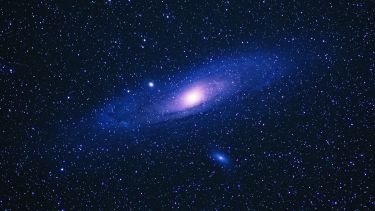- An international team of astronomers has discovered an extremely rare triple black widow using HiPERCAM, a high-speed camera that can take more than 1,000 optical images per second, which was developed by the University of Sheffield
- Black widow binaries are a pairing of two stars where a rapidly spinning neutron star, or pulsar, circles and slowly consumes a smaller companion star, as its arachnid namesake does to its mate
- The findings, published in Nature, also outline a new way to discover black widow binaries by identifying their companion stars instead of looking directly for the pulsars
- There are roughly two dozen identified black widows in the Milky Way, but this newly discovered one has the shortest orbital period yet identified, with the pulsar and companion star circling each other every 62 minutes
A rare triple black widow - a pair of stars that rapidly circle each other before one is consumed by the other - has been discovered by scientists.
The research, which involved astronomers from the University of Sheffield, has also unearthed a new way to find the stars in the future.
In the study, published in Nature, an international team of scientists led by MIT were drawn to a new and mysterious system 3,000 light years from earth exhibiting unique brightness variations. The stellar oddity appears to be a new black widow binary — a rapidly spinning neutron star, or pulsar, that is circling and slowly consuming a smaller companion star, as its arachnid namesake does to its mate.
Astronomers know of about two dozen black widow binaries in the Milky Way. This newest candidate, named ZTF J1406+1222, has the shortest orbital period yet identified, with the pulsar and companion star circling each other every 62 minutes. The system is unique in that it appears to host a third far-flung star that orbits around the two inner stars every 10,000 years.
The exotic triple black widow was found using HiPERCAM, a high-speed camera that can take more than 1,000 optical images per second, which was developed by researchers at the University of Sheffield. The discovery has raised questions about how such a system could have formed, with researchers speculating that as with most black widow binaries, the triple system likely arose from a dense constellation of old stars known as a globular cluster. This particular cluster may have drifted into the Milky Way’s centre, where the gravity of the central black hole was enough to pull the cluster apart while leaving the triple black widow intact.
Using Sheffield’s HiPERCAM, the research team used a new approach to detect the triple system. While most black widow binaries are initially found through the radio and gamma ray radiation emitted by the central pulsar, the team used visible light, and specifically the varying light from the binary’s companion star, to discover ZTF J1406+1222.
Professor Vik Dhillon, co-author of the study from the University of Sheffield’s Department of Physics and Astronomy, said: “Thanks to the extraordinary sensitivity of the Sheffield-led HiPERCAM camera, we have discovered the most extreme member of the black widow class of binary star, along with a promising new method of detecting such systems.”
Black widow binaries are powered by pulsars — rapidly spinning neutron stars that are the collapsed cores of massive stars. Pulsars have a dizzying rotational period, spinning around every few milliseconds, and emitting flashes of radio and high-energy gamma rays in the process.
Normally, pulsars spin down and die quickly as they burn off a huge amount of energy. But every so often, a passing star can give a pulsar new life. As a star nears, the pulsar’s gravity pulls material off the star, which provides new energy to spin the pulsar back up. The “recycled” pulsar then starts reradiating energy that further strips the star, and eventually destroys it.
Astronomers discovered the companion star’s day side — the side perpetually facing the pulsar — can be many times hotter than its night side, due to the constant high-energy radiation it receives from the pulsar. This allowed them to find the new black widow by looking for the companion star instead of looking directly for the pulsar.
The new method could make it easier to discover black widows in the future, as a star whose brightness is changing periodically by a huge amount is a strong signal that it’s a binary with a pulsar.
To test if the new theory works, the researchers looked through optical data taken by the Zwicky Transient Facility, an observatory based in California, which takes wide-field images of the night sky. The team studied the brightness of stars to see whether any were changing dramatically by a factor of 10 or more, on a timescale of about an hour or less — signs that indicate the presence of a companion star orbiting tightly around a pulsar.
The team was able to pick out the dozen known black widow binaries, validating the new method’s accuracy. They then spotted a star whose brightness changed by a factor of 13, every 62 minutes, indicating that it was likely part of a new black widow binary, which they labelled ZTF J1406+1222. The new discovery was then observed at much greater sensitivity with the Sheffield HiPERCAM camera, mounted on the world's largest optical telescope, the 10.4m Gran Telescopio Canarias on La Palma, which allowed the system to be studied in much greater detail.
Curiously, the astronomers have not directly detected radio or gamma ray emissions from the pulsar in the binary, which is the typical way in which black widows are confirmed. ZTF J1406+1222, therefore, is considered a candidate black widow binary, which the team hopes to confirm with future observations.
Kevin Burdge, Lead Author and a Pappalardo Postdoctoral Fellow from MIT’s Department of Physics, said: “The one thing we know for sure is that we see a star with a day side that’s much hotter than the night side, orbiting around something every 62 minutes. Everything seems to point to it being a black widow binary. But there are a few weird things about it, so it’s possible it’s something entirely new.
“The newly discovered triple black widow has a complicated birth scenario - this system has probably been floating around in the Milky Way for longer than the sun has been around.
“The whole thing is really unique as far as black widows go, because we found it with visible light, and because of its wide companion, and the fact it came from the galactic centre. There’s still a lot we don’t understand about it. But we have a new way of looking for these systems in the sky.”
The team plans to continue observing the new system, as well as apply the optical technique to discover more systems.
Alongside MIT and Sheffield, the research team also included academics from the University of Warwick, Caltech, the University of Washington, McGill University, and the University of Maryland.
This research was supported in part by the National Science Foundation.
You can find the paper in full here.
Contact
For further information please contact:



